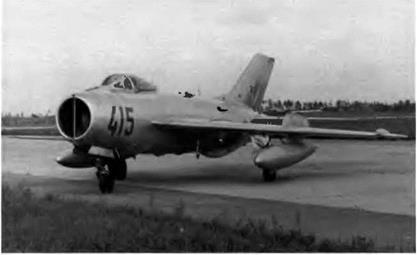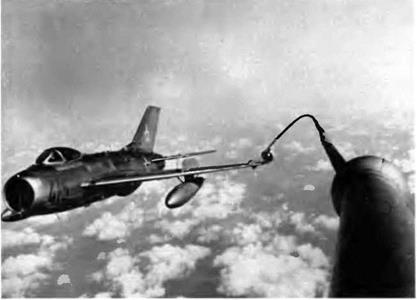MiG 198 / SM10
The purpose of this project was to give longer legs to the MiG-19 by refueling the aircraft in flight. Of course, the ОКБ had already conducted refueling experiments with the MiG-15. In May 1954 a decree of the council of ministers ordered the ОКБ to build a MiG-19 equipped with in-flight refueling devices and to convert a Tupolev Tu-16 into a tanker aircraft. The same decree secured the financing for the program. The ОКБ designed a flexible hose unreeled behind the Tu-16 whose tip was supposed to be seized by a kind of trap located near the left wing tip of the fighter.
|
The MiG-19S no. 415 (SM-10) had a special clutching device near the left wing tip for in-flight refueling trials. |
The modified MiG-19S or SM-10 was built in mid-1955. On 29 September another governmental decree named the pilots in charge of the tests: V. A. Nefyedov, the OKB chief pilot, and V. N. Pronyakin, a military test pilot with the LII. The chief engineers in charge of supervising the tests were A. I Komisarov for the OKB and 1.1. Shelyest for the LII. To refuel, the fighter pilot first had to adapt his speed to that of the tanker and then lean the left wing tip of his fighter against the tip of the hose. As soon as contact was made the hose tip was securely connected, and with the help of its powerful pumps the Tu-16 transferred the fuel in a very short time because the flow rate was approximately 1,000 liters per minute (264 US gallons per minute). The refueling sequence took place at 450-500 km/h (243-270 kt) at 9,000-10,000 m (29,500-32,800 feet).
When the tanks of the SM-10 were full, the pumps stopped short and the two aircraft separated. The tanker operator could stop the refueling sequence at any time. (It is interesting to note that this tanker version or Tu-16N could use a unique wing tip-to-wing tip transfer technique to refuel Tu-16 bombers.) The refueling sequence could be repeated several times during a single flight and was possible in the daytime or on a clear night with the help of a wing-mounted floodlight. Because the oxygen reserve of the MiG-19S was found to be insufficient, that of the SM-10 was increased to 18 1 (4.7 US gallons).
|
The tip of the flexible hose unreeled by the tanker aircraft was clutched by a kind of trap located near the SM-lO’s wing tip. |
After its factory tests, the SM-10 passed its state acceptance trials in 1956 But this version was not produced for reasons that Western military authorities would not have thought possible that year a large share of the Soviet defense budget was funneled to the design and production of surface-to-surface ballistic missiles, so tbe WS could not afford to develop the tanker aircraft it needed. This policy was revised in the early 1980s, and today most of the operational MiG-25s and all of the MiG-3 Is are equipped with in-flight refueling systems.












